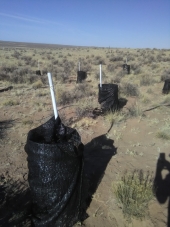Plants that are edible and do decent in this climate are rhubarb, strawberries, stone fruits (peaches and nectarines) though mine haven’t yet put off fruit, they seem to be doing well, root vegetables such as beets, onions, carrots and garlic, kale, lettuce, broccoli, sunflowers. If I think of more I’ll post them. I’m not a fan of using plastic covers for my plants, so currently I am stock piling blankets for fall and thereafter. I got decent germination rates from my Siberian pea shrubs, black and honey locusts, but I won’t know how they over winter until next year. My prickly pear cacti have yet to grow since last year. I will be messing with more straw bales this next year for wind breaks and three sided beds with mini swales and a berm on the south side, all sizes to be covered with blankets that will be folded and left on the north edge for quick coverage. For animal pests last year I revamped my fencing, but my roommate has yet to learn how to shut gates behind him, so they’ve done little good. For insect pests I’ve built rock cribs to be inhabited by lizards, though the mice love them too. Southwest medium sized berms should be implemented here and planted heavily with perrenials that can add leaves to the sand, since most of our wind comes from that direction. Temporary wind barriers could be a heavy saturation of sun flowers in a on the west side of the berms, stalks could be used for mulch afterwards. Just thoughts




